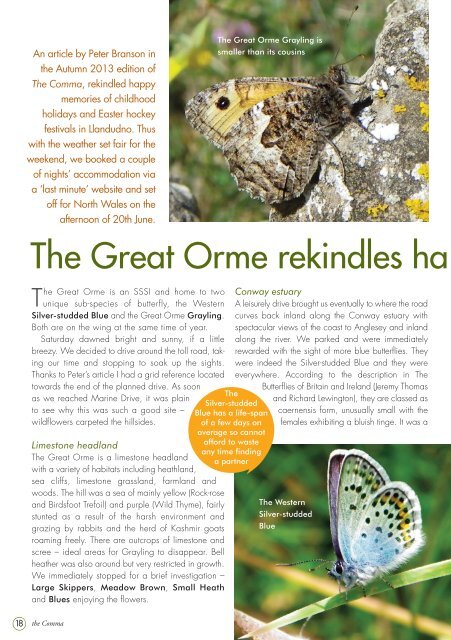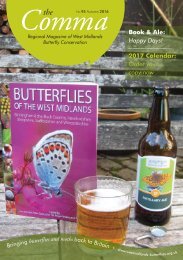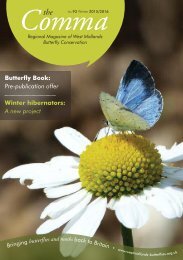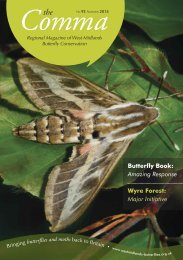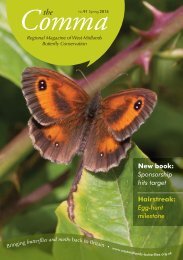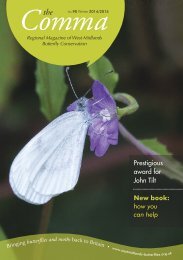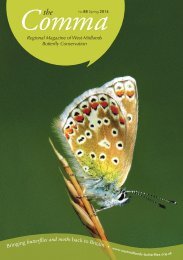Comma-WestMidBC-autumn-2014
Butterfly Magazine for the West Midlands Branch of Butterfly Conservation
Butterfly Magazine for the West Midlands Branch of Butterfly Conservation
You also want an ePaper? Increase the reach of your titles
YUMPU automatically turns print PDFs into web optimized ePapers that Google loves.
An article by Peter Branson in<br />
the Autumn 2013 edition of<br />
The <strong>Comma</strong>, rekindled happy<br />
memories of childhood<br />
holidays and Easter hockey<br />
festivals in Llandudno. Thus<br />
with the weather set fair for the<br />
weekend, we booked a couple<br />
of nights’ accommodation via<br />
a ‘last minute’ website and set<br />
off for North Wales on the<br />
afternoon of 20th June.<br />
The Great Orme rekindles ha<br />
The Great Orme is an SSSI and home to two<br />
unique sub-species of butterfly, the Western<br />
Silver-studded Blue and the Great Orme Grayling.<br />
Both are on the wing at the same time of year.<br />
Saturday dawned bright and sunny, if a little<br />
breezy. We decided to drive around the toll road, taking<br />
our time and stopping to soak up the sights.<br />
Thanks to Peter’s article I had a grid reference located<br />
towards the end of the planned drive. As soon<br />
as we reached Marine Drive, it was plain<br />
to see why this was such a good site –<br />
wildflowers carpeted the hillsides.<br />
Limestone headland<br />
The Great Orme is a limestone headland<br />
with a variety of habitats including heathland,<br />
sea cliffs, limestone grassland, farmland and<br />
woods. The hill was a sea of mainly yellow (Rock-rose<br />
and Birdsfoot Trefoil) and purple (Wild Thyme), fairly<br />
stunted as a result of the harsh environment and<br />
grazing by rabbits and the herd of Kashmir goats<br />
roaming freely. There are outcrops of limestone and<br />
scree – ideal areas for Grayling to disappear. Bell<br />
heather was also around but very restricted in growth.<br />
We immediately stopped for a brief investigation –<br />
Large Skippers, Meadow Brown, Small Heath<br />
and Blues enjoying the flowers.<br />
The Great Orme Grayling is<br />
smaller than its cousins<br />
The<br />
Silver-studded<br />
Blue has a life-span<br />
of a few days on<br />
average so cannot<br />
afford to waste<br />
any time finding<br />
a partner<br />
Conway estuary<br />
A leisurely drive brought us eventually to where the road<br />
curves back inland along the Conway estuary with<br />
spectacular views of the coast to Anglesey and inland<br />
along the river. We parked and were immediately<br />
rewarded with the sight of more blue butterflies. They<br />
were indeed the Silver-studded Blue and they were<br />
everywhere. According to the description in The<br />
Butterflies of Britain and Ireland (Jeremy Thomas<br />
and Richard Lewington), they are classed as<br />
caernensis form, unusually small with the<br />
females exhibiting a bluish tinge. It was a<br />
The Western<br />
Silver-studded<br />
Blue<br />
18<br />
the <strong>Comma</strong>


